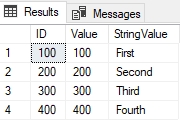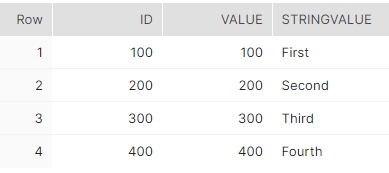Common Table Expression (CTE)
Common table expressions are supported in Snowflake SQL by default.
Snowflake SQL syntax
Subquery:
[ WITH
<cte_name1> [ ( <cte_column_list> ) ] AS ( SELECT ... )
[ , <cte_name2> [ ( <cte_column_list> ) ] AS ( SELECT ... ) ]
[ , <cte_nameN> [ ( <cte_column_list> ) ] AS ( SELECT ... ) ]
]
SELECT ...Recursive CTE:
[ WITH [ RECURSIVE ]
<cte_name1> ( <cte_column_list> ) AS ( anchorClause UNION ALL recursiveClause )
[ , <cte_name2> ( <cte_column_list> ) AS ( anchorClause UNION ALL recursiveClause ) ]
[ , <cte_nameN> ( <cte_column_list> ) AS ( anchorClause UNION ALL recursiveClause ) ]
]
SELECT ...Where:
anchorClause ::= SELECT <anchor_column_list> FROM ... recursiveClause ::= SELECT <recursive_column_list> FROM ... [ JOIN ... ]
Noteworthy details
The RECURSIVE keyword does not exist in T-SQL, and the transformation does not actively add the keyword to the result. A warning is added to the output code in order to state this behavior.
Common Table Expression with SELECT INTO
The following transformation occurs when the WITH expression is followed by an SELECT INTO statement and it will be transformed into a TEMPORARY TABLE.
SQL Server:
Snowflake:
Common Table Expression with other expressions
The following transformation occurs when the WITH expression is followed by INSERT or DELETE statements.
SQL Server:
Snowflake:
Common Table Expression with Delete From
For this transformation, it will only apply for a CTE (Common Table Expression) with a Delete From, however, only for some specifics CTE. It must have only one CTE, and it must have inside a function of ROW_NUMBER or RANK.
The purpose of the CTE with the Delete must be to remove duplicates from a table. In case that the CTE with Delete intents to remove another kind of data, this transformation will not apply.
Let's see an example. For a working example, we must first create a table with some data.
Note that there is a duplicated value. The lines 8 and 12 insert the same value. Now we are going to eliminate the duplicates rows in a table.
If we execute a Select from the table, it will show the following result

Note that there are no duplicateds rows. In order to conserve the functionality of these CTE with Delete in Snowflake, it will be transformed to
As you can see, the query is transformed to a Create Or Replace Table.
Let's try it in Snowflake, in order to test it, we need the table too.
Now, if we execute the result of the transformation, and then a Select to check if the duplicated rows were deleted, this would be the result.

Common Table Expression with MERGE statement
The following transformation occurs when the WITH expression is followed by MERGE statement and it will be transformed into a MERGE INTO.
SQL Server:
Snowflake:
Common Table Expression with UPDATE statement
The following transformation occurs when the WITH expression is followed by an UPDATE statement and it will be transformed into an UPDATE statement.
SQL Server:
Snowflake:
Related EWIs
SSC-EWI-0108: THE FOLLOWING SUBQUERY MATCHES AT LEAST ONE OF THE PATTERNS CONSIDERED INVALID AND MAY PRODUCE COMPILATION ERRORS.
SSC-PRF-TS0001: Performance warning - recursion for CTE not checked. Might require a recursive keyword.
Last updated